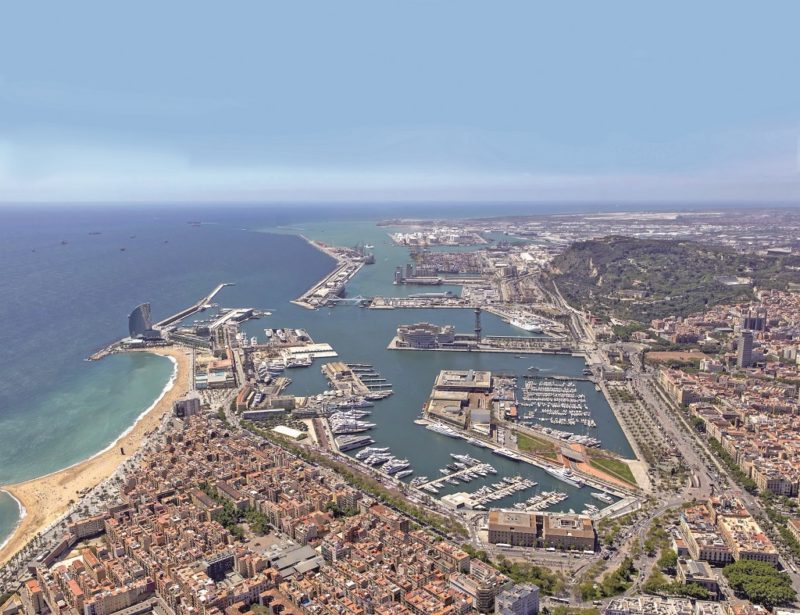
The Port of Barcelona is very large, and in total, the port has 1,100 hectares of land dedicated to cruise ship and ferry berths, dry and liquid cargo handling, and container handling with 22.4 kilometres of berths and alongside depths of up to 16.0 metres. There are over one hundred shipping lines connecting the port to two hundred ports on five continents. The port has a long history dating back two thousand years as well as having a very great commercial importance as one of the major ports of Europe in the Mediterranean. The port is divided into three zones, the Old Port of Port Vell, the commercial port, and the logistics and container port, and it is managed by the Barcelona Port Authority. This is not the only port in Barcelona, as there are two additional yacht marinas in Port Olimpic and Port Forum Sant Adria to the north.
The whole of Catalonia is the hinterland of the Port of Barcelona, with an area of influence that stretches from the south of Europe to the Balearic islands and North Africa. Passenger traffic has increased from 2.88 million passengers in 2007 to 4.51 million passengers in 2018. Visitors come to see the great cathedral of Sagrada Familia, the life work of Antonio Gaudi, now with a fixed completion date after well over a century of construction work. Gaudi was born in Barcelona along with Picasso, Joan Miro and Salvador Dali and other great artists, but he was the only one to stay and work there for the rest of his life. The Paseo de Gracia, fantastic roof tops of buildings on Las Ramblas, the main street of the city, and Parc Guell are his other masterpieces in the city, the latter with a unique style of ceramic shapes, colourful lizards, entrance lodges with fantastic chimney pots, and seats patterned with ceramic pieces. There are also two storey cottages with very curved white roofs of a very quaint design. These sublime statements of a very singular style are unique and well worth a visit. Picasso painted an oil canvas of the Columbus (Colon) Tower Monument, at the meeting point of the port and the city, in 1917 before he moved to Paris and later to Malaga.
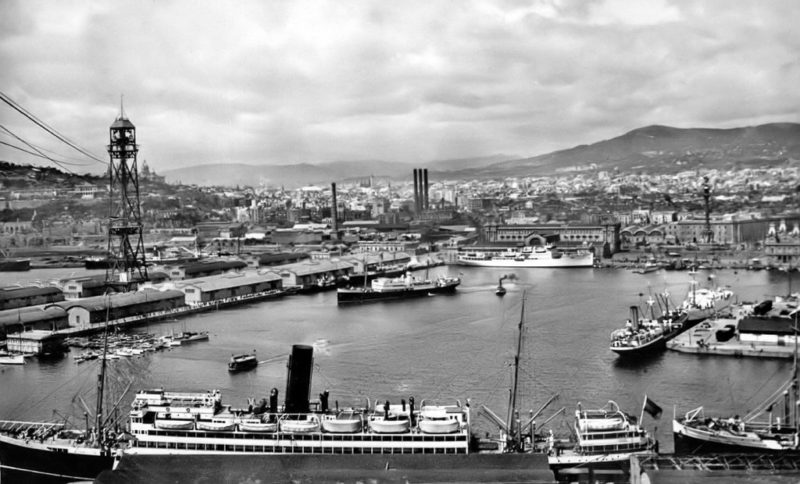
HISTORY OF BARCELONA
The City of Barcelona began building its walls for fortification back in the year 263 AD, not long after the first Barbarian invasions terrified the inhabitants. The King and Queen of Aragon owned the city as their capital between the years 1164 to 1285, with this influence culminating in the reign of Ferdinand and Isabella between 1452 and 1516. Ferdinand was born a Prince of Aragon to the north of Catalonia, and by his marriage to Isabella, Queen of Castile, the two thrones were united, thereby forming the powerful kingdom of Aragon and Castile. The reign of Isabella and Ferdinand was of unparalleled importance to the history of Spain, and their Christian Army succeeded in the driving out of Spain the last Muslims from Granada in 1492.
The weak protection offered by the anchorage of Barcelona to the ships anchored in the inlet that formed the port, resulted in many shipwrecks between the 10th to 12th centuries. Masons were employed to build the first wharves of the port on a gentle slope leading down to the sea, which allowed it to expand unimpeded with the Llobregat and Besos rivers providing water. The port did not have a natural harbour such as the Porto Vecchio in Genoa, and there was a constant battle against the invasion of sand at the new stone wharves.
The same stone masons that built the early wharves of the port also built the beautiful first church in the city, that of the Santa Maria del Mar (Cathedral of the Sea). It is built in a beautiful Gothic style between 1329 and 1383 with a tall nave with some early coloured glass in the windows. Various types of sandstone and granite were used, and thin masonry timbrel makes up much of the vaulting. However, unlike most of the churches built around this time, it was built by the people, everyone contributed money and time during its construction. Certain elements of the church are surrounded by a long history e.g. the main door, which was homage to the ‘bastaixos’ (porters) who brought stones from the beach which were to be used for its construction.
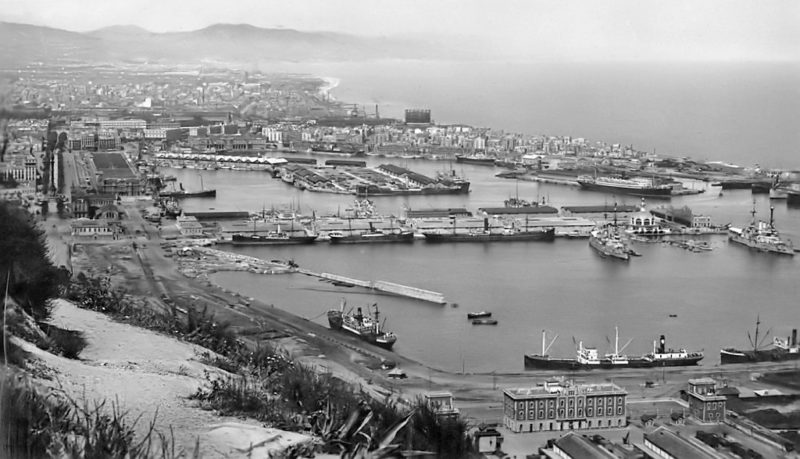
Over the years, the church of Santa Maria del Mar established a bond with the people of the city and of Catalonia e.g. there is a white mulberry tree that grew in the cemetery of the church, where all Catalans who died in the Siege of Barcelona in 1714 were buried and can be found, and where the National Holiday of Catalunya is commemorated. The church should not be confused with the Cathedral of Barcelona (La Seu). The book entitled ‘La Catedral del Mar’ by Ildefonso Falcones gives a good description of the stone masons that built both the church and the stone wharves of the early port.
Saint Eulalia was a martyr during the reign of the Roman Empire, who lost her life after refusing to dismiss her belief in Jesus as the Son of God. The crypt in the vault of Barcelona Cathedral (La Seu) contains her tomb. The Cathedral has a stunning interior with many Gothic paintings that form altarpieces. The wooden seats of the choir are original and date back to the 14th and 15th centuries with images of the Order of the Golden Fleece on their backs. All of the stained glass windows have three panels, with the central panel displaying the image of an important Barcelona person, while the side panels contain geometric designs symbolising the royal families of the area e.g. King Alfonso V.
The Port of Barcelona has a long history encompassing the Holy Cross Pier or Old Pier built shortly after the first stone was laid in 1477, the East Dock extension of 1723, and the Linterna tower of 1772. The construction of an outer sea wall to the East Dock solved the problem of shifting sand and the very restricted depth of the port. A sheltered water area of 110 hectares was formed after a Royal Decree was issued on 14th October 1868 for the improvement of the port. A major project between the years 1877 and 1882 resulted in the first cross pier being built. New wharves named Espanya, Barcelona, Fishermen’s, Baleares and Catalunya were built between 1901 and 1912, with a new extension to the East Pier built in 1926. In post-World War II years, the port began extending to the south from 1958 with long new outer sea walls completed in 1962, resulting in a sheltered area of around 500 hectares in 1968. Two important projects were completed in 2008, the East and South seawalls at a cost of €501 million, and the new Pilots Tower at a cost of €6.2 million. The new Energy Wharf in the oil and gas port to the south also has a tower of seven storeys in height (45 metres) and was also completed at this time.
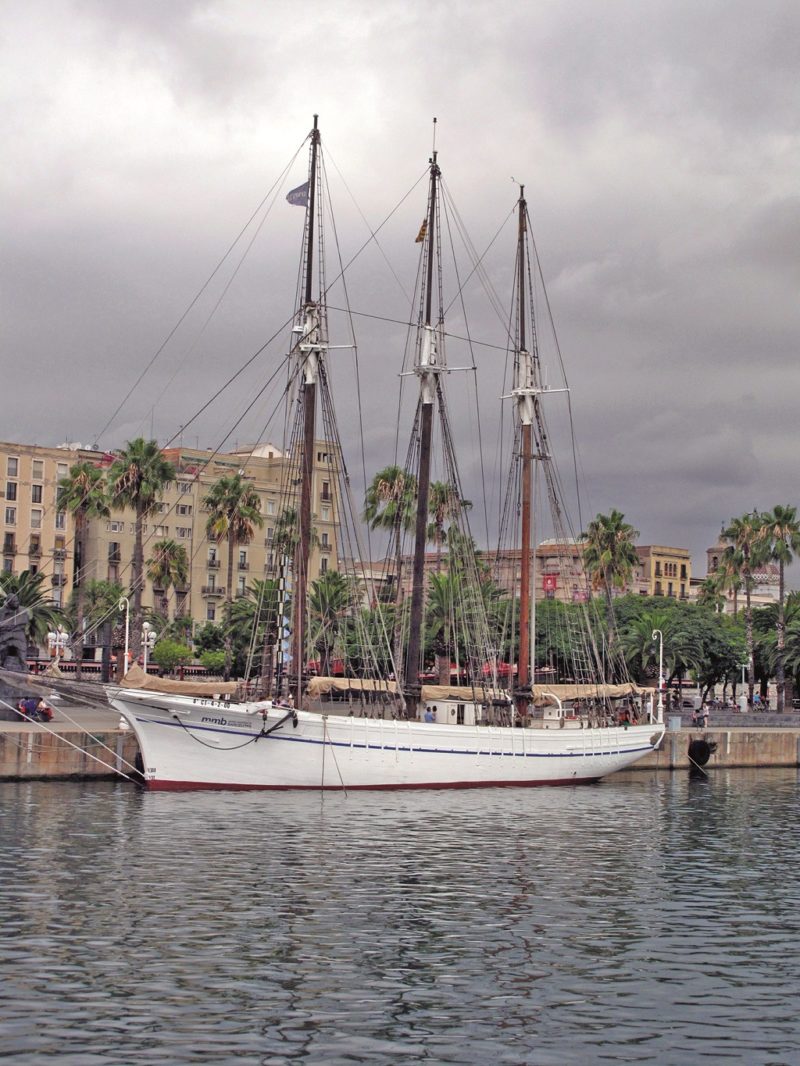
Port Vell or Old Port with a very long history comprises two marinas for yachts, a fishing port and an important ferry terminal for voyages to Italy, the Balearic islands and other ports in the Western Mediterranean. In the central area of Port Vell stands the big Maremagnum shopping mall and is open seven days a week and on public holidays, a multiplex cinema, and a large aquarium containing over 8,000 fish and sharks in 22 large tanks filled with six million litres of seawater. The ‘Golondrines’ harbour tourist boats are berthed next to the Maremagnum.
The three masted schooner Santa Eulalia of 220 grt with an overall length of 31.0 metres and a beam of 8.7 metres is berthed on the Moll de la Fusta and the Passeig de Colon near the Columbus (Colon) Tower. She was built in 1918 at Torrevieja (Alicante) for the shipowner Pascual Flores and was named in honour of his daughter as Carmen Flores. She transported grain, wood, salt, coal and minerals throughout the Mediterranean and also across the Atlantic to Cuba, and due to her speed, she gained the nick name of El Chulo (Fast One). She has been overhauled many times during her long career of over 100 years, and was fitted with her first engine in 1928, and then converted into an auxiliary powered vessel in 1975 for offshore underwater work. She changed her name to Puerto de Palma (1931), Cala San Vicence (1936) and Sayremar Uno in 1975. In 1997, the Maritime Museum of Barcelona purchased her at a public auction with the aim of conserving one of the last existing schooners in the Mediterranean. During 1998 and 1999, she was restored to her original appearance, and was renamed Santa Eulalia in 2000 in honour of the joint patron of the City of Barcelona.
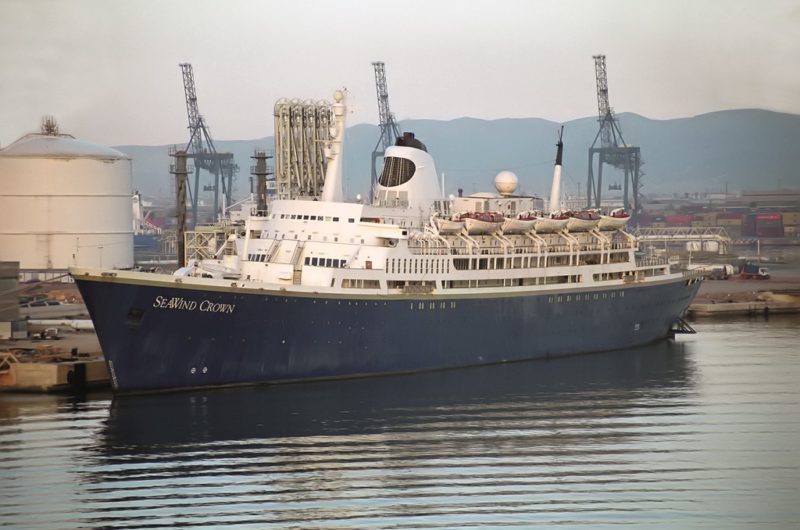
BARCELONA ROYAL SHIPYARD and the BARCELONA MARITIME MUSEUM
A very big port such as the Port of Barcelona has a long history with over seventy port agents operating in the port with generations of families closely connected to the port for many centuries. The Barcelona Royal Shipyard has Gothic architecture and operated from eight ‘naves’ or building berths of length 60 metres and 8.4 metres in width and height, arranged in parallel, and in the Drassanes area of the Port Vell. Today, it also houses the Barcelona Maritime Museum. Construction of the yard began in the 13th century under the rule of Peter III of Aragon, who in 1285 ordered the construction of a yard with fortified walls and four towers on a rectangular plan but with no roofs.
During excavations in 2012, it was discovered that in the late 16th century a new building was constructed on top of the old medieval dockyard, giving the building its current structure. This restoration was completed during 2013, and the Barcelona Maritime Museum was reopened in 2014. Expansion of the yard continued during the period from 1328 to 1390 with the city walls expanded and included the shipyard inside the fortified city. A roof was added to prevent the deterioration of the galleys stored during winter.
Foundations for a Royal Palace were laid between 1390 and 1415 but this was never built on the site. A new dockyard was built around 1550 with Gothic architecture in line with the construction of the first port in Barcelona. The port had changed the currents and sand build up and moved the shore line several metres inland, causing severe flooding to the old medieval shipyard. In 1612, the Catalan Government decided to add three naves to the new dockyard building, and after the Catalan Revolt of 1640 to 1652, added both a military barracks and an arsenal. In 1725, two more barracks were constructed, one for cavalry and one for infantry, with the roofs of the two central naves converted into a single nave by 1749.
The aim of the shipyard was to build galleys for the Aragonese Armada with twelve galleys built during the reign of Alfonso V, and Royal Galley of John of Austria built in 1571, which was his flagship at the Battle of Lepanto. During the 18th century, the yard ceased to function as a shipbuilding yard, as the building of galleys had moved to Cartagena. After the War of the Spanish Succession, the site was used as an artillery unit repair and storage shop and barracks for the Spanish Army. In 1935, the building was donated to the City of Barcelona, which opened it as a Maritime Museum in 1941. The old shipyard site was declared a Cultural Site of National Interest on 5th May 1976.
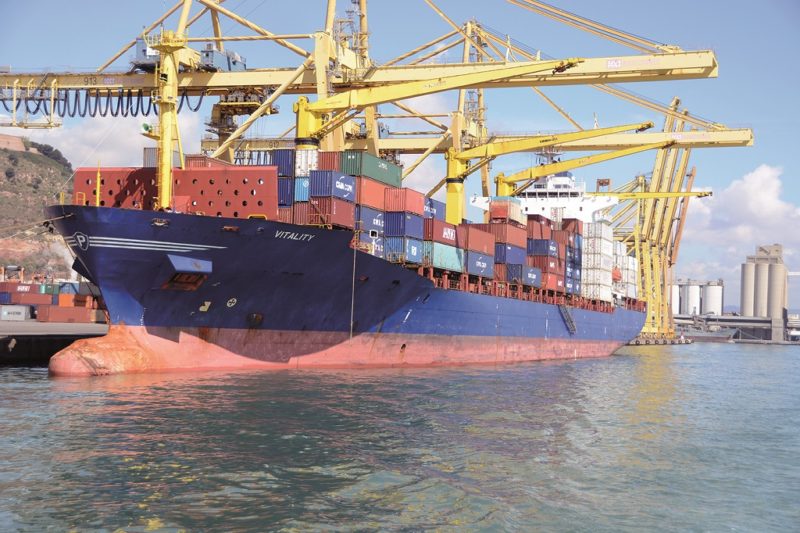
THE MODERN PORT
In common with many cities in Western Europe, the older traditional industries of Barcelona e.g. textiles, manufacturing industries of many types, warehouses, and railroad yards declined in the 1970s in the face of foreign competition. The surviving companies closed their factories in the city and in the suburbs, leaving abandoned industrial wastelands. In 1978, the Ministry of Public Works declared the Ports of Barcelona, Bilbao and Huelva to be autonomous ports. While remaining as Government owned bodies, they were able to function also as commercial enterprises subject to public law. In 1987, Barcelona Port Authority was formed with a very ambitious Strategic Plan to increase the port throughput dramatically. In November 1992, the central ports authority Puertos del Estado was formed, bringing an end to the autonomous nature of some ports, including the Port of Barcelona. During the period from 1993, the Port of Barcelona continued to expand, and during the period from 2001 to 2008 work was completed to divert the Llobregat river and relocate the river mouth two kilometres to the south, doubling the port area and creating the extensive container berths and the oil and gas tanker wharves in the south of the port.
Catastrophe struck the Port of Barcelona in the early hours of 17th January 1977 when a landing craft of the U.S. Navy helicopter carriers Guam and Trenton collided with the Spanish coaster Urlea of 390 grt in the inner Port Vell harbour. The landing craft was carrying 124 U.S. Navy sailors and marines back to their ships moored in the port. They were well dressed for the cold winter weather, but the vision of the coxswain of the craft had been momentarily blocked by the height of a dock wall. The collision lifted the bow of the landing craft and capsized it, throwing the occupants into the freezing water. Personnel at the U.S. Fleet Landing Pier scrambled to assist those floundering in the water or trapped underneath the hull of the craft. However, the tragic accident cost the lives of 49 U.S. naval personnel with 75 saved. When the two helicopter carriers sailed from the port a few days later, a Spanish woman dressed in traditional black slowly threw 49 large red roses into the harbour as a mark of respect for the dead.
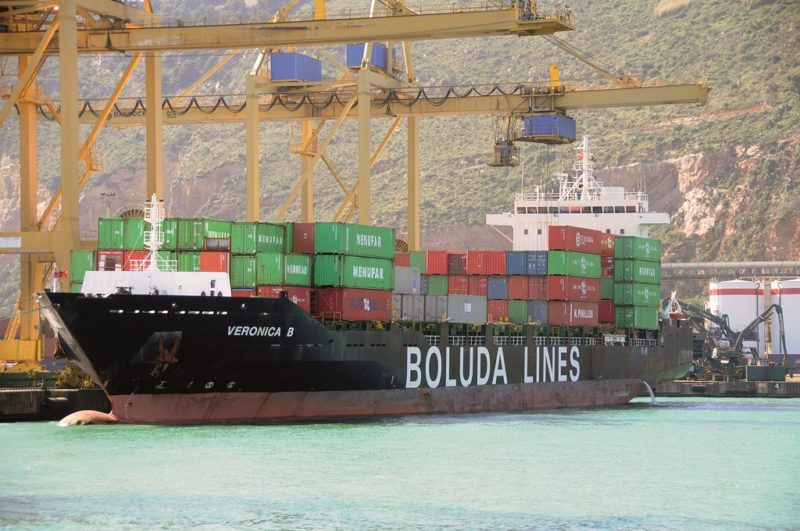
The Moll de la Fusta wharf in Port Vell opened to the public in 1981 to mark the start of the transformation of the north part of the port. The 1992 Summer Olympics were hosted in this area converted into an attractive harbour front in a huge urban renewal project. The neighbouring Barceloneta and its beaches were opened up to the sea, with large sculptures of fish and other designs built for the purpose of attracting visitors. The competitors and their trainers were housed in eleven cruise ships serving as floating hotels. In July 1999, the World Trade Centre was opened in the centre of the harbour. A good place to view the shipping in the port is from the high ground of Montjuic, and more specifically Montjuic Castle, as well as from the aerial ‘Transbordador’ cable car that connects the Barceloneta beach area to the World Trade Centre and to Montjuic. I used this ‘Transbordador’ cable car system during my holiday in Barcelona in 2003, giving vertical views downward into the centre of the circular shaped World Trade Centre, as well as of ships and yachts undergoing repairs on the Barceloneta side of the harbour. Seawind Crown owned by Premier Cruises and of 23,345 gt and built in 1961 as Infante Dom Henrique for Compania Colonial of Portugal, was laid-up on the east berth of the World Trade Centre between April and July 2003.
The Barcelona container, tanker and industrial port to the south also comprises the Zona Franca, a tariff free industrial park that has developed within the Port of Barcelona, across the flat land of the Llobregat delta between the city of Barcelona and that of El Prat de Llobregat and the El Prat Barcelona International Airport. This also pushed back part of the Llobregat Delta Nature Reserve in the interests of port development.
The Free Trade Zone (FTZ) offers a series of services, and a reception area, for detailed advice for investors into the port on such matters as customs duties, bonded warehouses, advanced telecommunication and computer systems, security systems, integrated transport mode systems, and also the reduction in tax free duties when setting up a factory or import and export facilities in the FTZ. Business investors can either rent or own these facilities, with the FTZ located within the port area and only 3.1 miles from Barcelona International Airport with modern highway and rail connections.
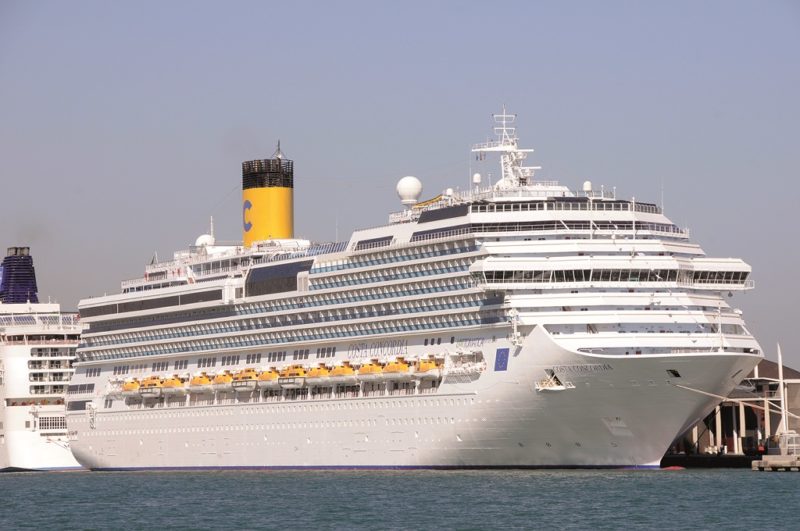
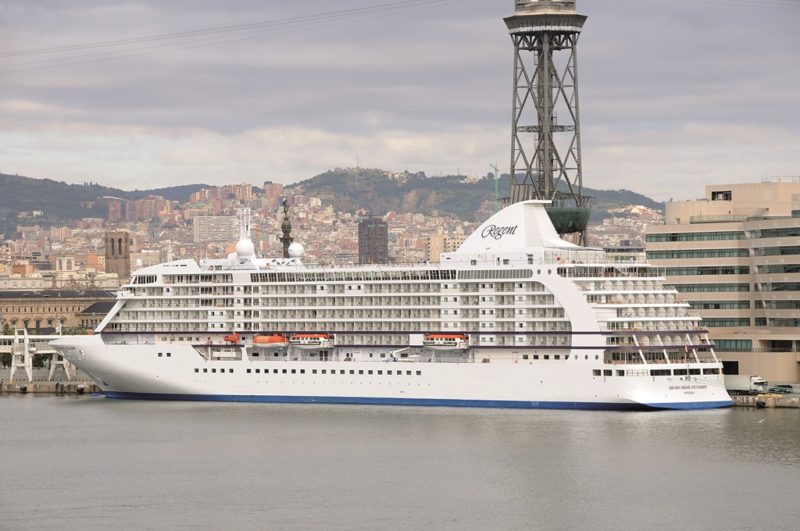
The Porta d’Europa bridge and the North entrance mouth to the port was opened in 2003, and are a substantial improvement for the Port Vell area, and for the port as a whole. The bridge, which was needed to connect the Adossat wharf and its berthed cruise ships to dry land, once the North entrance mouth was opened. This makes it possible to clearly segregate the traffic of the commercial harbour from that of yachts anchored at the yacht clubs, making the flow of vessels much safer. The North Entrance mouth was necessary because the seawall was extended by two kilometres to the south as part of the port enlargement plan. The Port of Barcelona thus has a South Entrance with a width of 1,214 feet and a draft of 52.5 feet, and a North Entrance with a width of 476 feet and a draft of 37.7 feet, and obviating the need for small yachts and craft to travel the much longer route from the South Entrance to Port Vell.
The Grimaldi Ro-pax ferry Excellent collided with a gantry crane in the harbour on 31st October 2018, causing it to topple over onto containers holding flammable chemicals, releasing clouds of toxic smoke and setting the wharf on fire. A very heavy wind and driving rain also caused four containers on her top deck to fall into the harbour. Several fire-fighting units were despatched to the scene and deployed to put out the fires on the crane and wharf, and they were on the scene for the rest of the day assessing the risk of further flare-ups of fire. The ferry had been quickly moved by tugs and under her own power to safety. No people were injured in the incident, but a number of ambulances attended the dock wharf in case they were needed. The cause of the accident was put down to severe weather conditions and possible steering gear problems on the ferry.
The product tanker Black Star, registered in Malta, was refused entry to the Port of Barcelona on 27th April 2022 as she was allegedly carrying a cargo of Russian oil to the European Union. This was in line with Russian cargoes of oil being refused entry at all other European Union ports, and cargoes of LNG being refused to be handled by dockers at the Isle of Grain LNG facility on the Thames due to the Russian invasion of Ukraine.
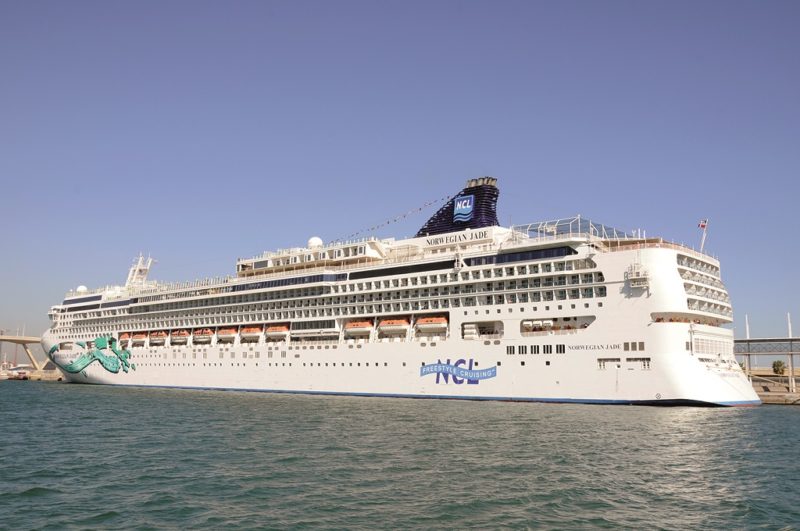
PORT OF BARCELONA BERTHS – CRUISE SHIP TERMINALS
Terminal A on Adossat Wharf with a berth length of 1,380 metres, alongside depth of 10.2 to 11.0 metres, a wharf width of 22.0 metres, and a passenger turnover of 4,500 passengers per day. It has an indoor area of 6,500 m2 and is two kilometres from the city centre by electric shuttle buses.
Terminal B on Adossat Wharf with a berth length of 1,380 metres, alongside depth of 10.2 to 11.0 metres, a wharf width of 22.0 metres, and a passenger turnover of 4,500 passengers per day. It has an indoor area of 6,500 m2 and is two kilometres from the city centre by electric shuttle buses.
Terminal C on Adossat Wharf with a berth length of 1,380 metres and alongside depth of 11.4 metres, a wharf width of 23.0 metres, a passenger turnover of 3,800 passengers per day. It has an indoor area of 4,100 m2, and is 2.5 kilometres from the city centre by electric shuttle buses.
Terminal D on Adossat Wharf is known as Palacruceros Wharf for the dedicated use of Costa Crociere of Italy. It has a berth length of 1,380 metres, alongside depth of 12.3 metres, a wharf width of 22.0 metres, and a passenger turnround of 4,500 passengers per day. It has an indoor area of 10,000 m2, cost €12 million to build, and is 2.5 kilometres from the city centre by electric shuttle buses.
Terminal E on Adossat Wharf is the Helix Terminal for the dedicated use of Carnival Cruises ships. It has a berth length of 1,380 metres, alongside depth of 12.3 metres, a wharf width of 22.0 metres with a passenger turnround of 4,500 passengers per day. It has an indoor area of 12,500 m2, cost €14 million to build, and is 2.8 kilometres from the city centre by electric shuttle buses.
Terminal M on the end of the Maremagnum Shopping Mall in Port Vell serves smaller cruise ships and as an overflow cruise ship berth. A terminal area of 480 m2, and a berth of 220 metres with an alongside depth of 8.6 metres, can serve arriving vessels with up to 200 passengers.
Terminal WTC (World Trade Centre) with both North and South passenger terminals, the East side is used for vessels in transit or to lay-up. The North berth is of 281 metres, the South berth is of 350 metres, and the East berth is of 160 metres, with alongside depths of 8.0 metres. The passenger turnround is 800 passengers for the North Terminal and 1,400 passengers for the South Terminal. The width of the three berths is from 14.0 to 20.0 metres and the distance to the city is a short walk of 400 metres.
All of the cruise terminals outlined above have duty free shops, big relaxation and waiting lounges, VIP lounges, immigration facilities, metal detectors, X-Ray machines, air conditioning, passenger gangways, luggage conveyors, carousels, public telephones and toilets, and foreign exchange currency conversion. Shore excursions are arranged for cruise passengers to the wine tasting and growing vineyards of the Freixenet or Codornfu regions of the area, the handsome medieval city of Girona flanking the river Onyar, the beach resorts of Tossa del Mar, Sant Pol de Mar and south to the Ebro delta nature reserves. Barcelona is a city with all of the art, history and street life one could need, and sandy beaches with an abundance of sunshine, together with forested hills criss-crossed by quiet walking trails with magnificent sweeping views.
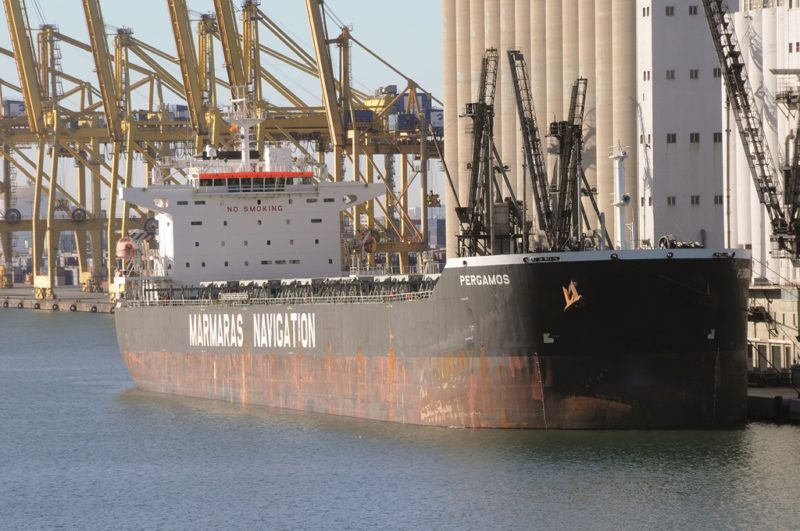
CRUISE LINE CALLS in 2022
- MSC Cruises 100
- Costa Cruises 85
- Aida Cruises 40
- Royal Caribbean International 30
- Norwegian Cruise Line 20
- Marella Cruises 18
- Celebrity Cruises 18
- Viking Ocean Cruises 16
- Viking Voyages 15
- Oceania Cruises 15
- TUI Cruises 15
- Princess Cruises 13
- Seabourn Cruises 13
- P & O. Cruises 13
- Regent Seven Seas Cruises 12
- Cunard Line 10
- Azamara Cruises 10
- Carnival Cruises 8
- Silversea Cruises 8
- Windstar Cruises 5
- Disney Cruises 3
- Saga Cruises 3
- Le Ponant Cruises 2
- Hapag-Lloyd 2
- Phoenix Seereisen 2
- Nicko Cruises 2
- Fred. Olsen Cruises 2
- Sea Dream Cruises 1
- La Belle des Oceans 1
GRAND TOTAL 484
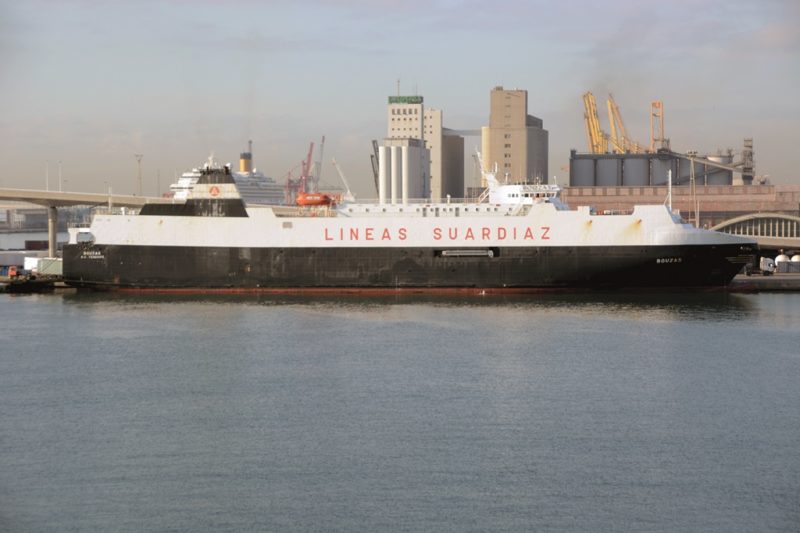
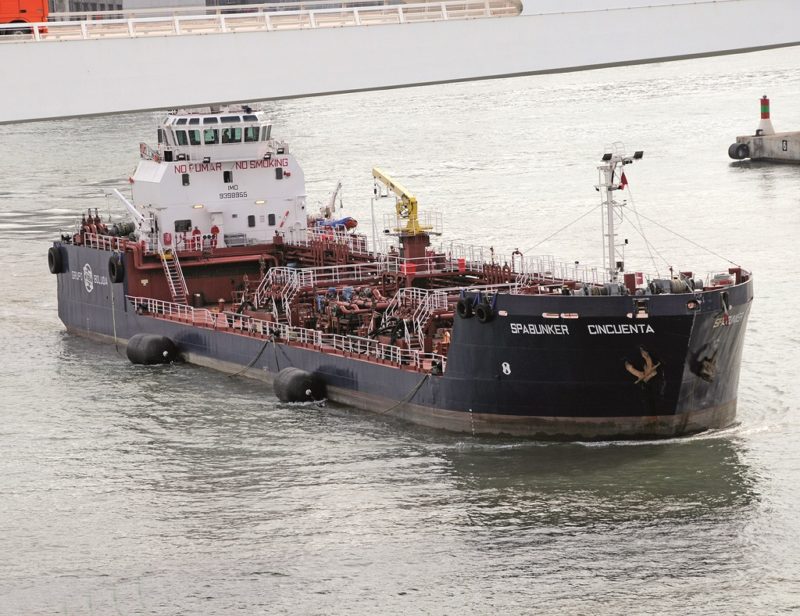
CONTAINER TERMINALS
APM TERMINALS BARCELONA on the South Wharf and BARCELONA EUROPE SOUTH TERMINAL (BEST) on the Prat Wharf are the two container terminals. Together, these two terminals have the combined facilities of:-
- A total of over 3,000 metres of quay length
- Each terminal uses 14 Super Post Panamax large Gantry Cranes
- 16.0 metres alongside depth for Super Post Panamax container ships
- Rail facilities to ease handling and onward shipment
- Container lines served include Maersk Line, Evergreen Line, CMA-CGM, COSCO, Ignazio Messina, JSV Logistics, MSC, Maghreb Line, CNAN MED Line, Hapag-Lloyd, Neptune Lines, ONE of Japan, Yang Ming, Arkas Line, Algerienne Nationale, Boluda Line, Euro Marine Logistics, Turkon Line, Qatar Navigation Line, Seago Line, WEC, Zim Line and many other deep sea and feeder lines.
BEST TERMINAL
Inaugurated on 27th September 2012 to the south of the oil and gas wharves, and celebrated its 10th Anniversary in 2022. Joint tender submitted in 2006 by Hutchison Port Holdings and Mestre Group, the latter withdrew in 2011. Tax incentives can be claimed by new investors in this area, as this big, new container terminal is very close to the Free Trade Zone (FTZ), Zona Franca, and ZAL (Logistics Activities Zone). Equipment as follows:-
- 14 ZPMC Super Post Panamax Gantry Cranes with outreach of 64 metres, maximum load of 60 tonnes
- 54 KONE Automatic Stacking Cranes to a height of 18 metres, maximum load of 40 tonnes
- 34 KALMAR Straddle Carriers with maximum load of 50 tonnes
- 80 Hectares of container storage space, 16 Trains daily to all parts of Spain and Southern France
- 2.5 million TEU handled each year, 2,800 trucks handled each day
- 16.5 to 18.0 metres alongside depth
- 132 hectares of land, 7 berths of 2,100 kilometres in length
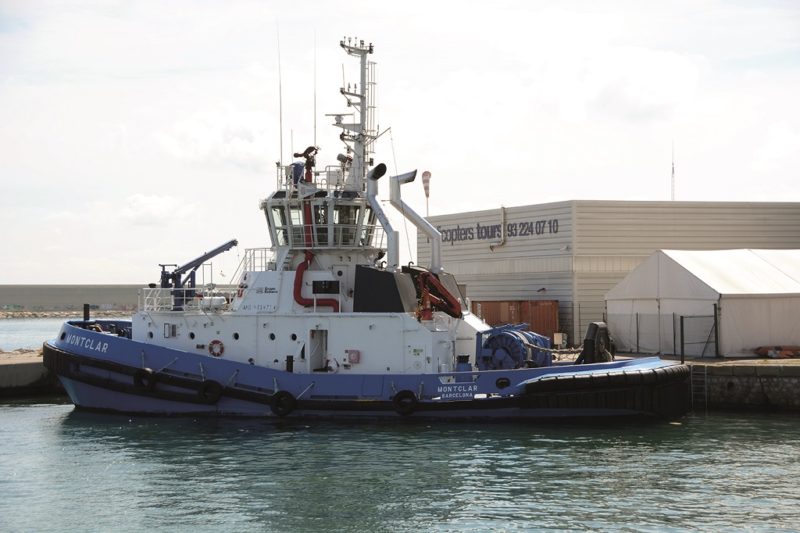
APM TERMINAL
Maersk Line and APM Terminals of Denmark have invested €170 million in this terminal to the north of the oil and gas terminals in order to handle the biggest container ships today and the bigger vessels due to come into service up to 18,000 to 24,000 TEU capacity. Some 80% of the containers handled are to and from the immediate hinterland of Barcelona, and particularly the textile, automotive, chemical, pharmaceutical and electric and electronics industries. Containers are taken to the big distribution centres of IKEA, LIDL, Decathlon, Schneider Electrics and Electronics, Honda Logistics, Inditex and Mango Logistics. APM Terminals operate a South East Wharf and a North East Wharf, with combined capacity of 1.65 million TEU per year, and four berths on 42 hectares of land, with a large number of rubber tyred gantry cranes, reach stackers, straddle carriers and forklifts. The split between the two wharves is as follows:-
South East Wharf
- Length of 1,155 metres
- Maximum vessel length 400 metres
- Maximum vessel size 18,000 TEU
- Alongside depth of 12 to 14 metres
- 11 Gantry Cranes of 23 rows extension
North East Wharf
- Length of 350 metres
- Maximum vessel length 300 metres
- Maximum vessel size 3,000 TEU
- Alongside depth of 12 to 14 metres
- 3 Gantry Cranes of 13 rows extension
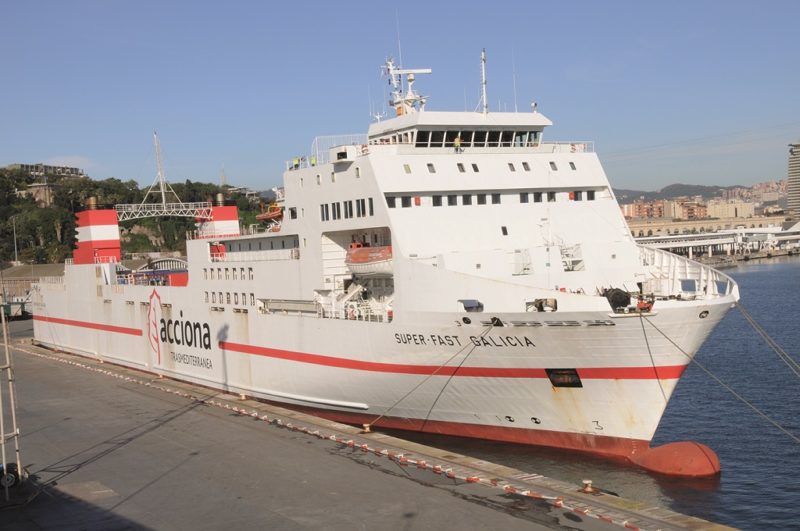
LIQUID BULK CARGOES
These essential but dangerous cargoes are handled south of the container terminals in the oil and gas port, with wharves such as Energy Wharf, Parc Delta 1 Wharf, and Passeig Can Tunis Wharf, by the following big oil and gas companies:-
Meroil – Seven loading berths for fuel oil and petrol, over one million m3 of storage in the biggest liquid terminal on the Spanish coast.
CLH – two loading berths of alongside depths 13.5 metres and 11.6 metres, 44 tanks of 522,000 m3 storage capacity for Avgas, lubricants, diesel and fuel oils. The company has a vast network throughout Spain and the Balearic islands for the storage of 7.8 million m3 of liquid cargo.
Relisa (Receptora de Liquidos S.A.) – three loading berths each of 180 metres length, 11.0 metres alongside depth, loading rate up to 700 m3s/hour, 127 tanks of 200,000 m3 capacity for chemicals, vegetable oils, fats, latex, molasses, biofuels, glycerins etc. Storage capacity of 200,000 m3 on 2.7 hectares in 127 tanks. Unloading and loading at rates up to 700 m3 per hour.
Royal Vopak – 1 berth of 11.8 metres alongside depth for oil, chemicals, biofuels, lubricants, vegetable oils, oleochemicals and alcohol stored in 44 tanks of 213,000 m3.
Tepsa (Terminales Portuarias S.A.) – five loading berths with a total length of 1,000 metres and alongside depths up to 15.1 metres. Tepsa was founded in 1964 and has 344 tanks with a storage capacity of 99.3 million m3 or three million U.S. barrels of petrol, biofuels and chemicals.

Tradebe S.A. – chemical plant with 29 storage tanks of 453,000 m3 capacity
Enagas S.A. – six tanks of 760,000 m3 of LNG, loading rate 4,500 m3/hour for the release through 6,200 miles of pipeline through Spain, with also two underground storage facilities and three regasification plants.
Decal Espana S.A. – 447,000 m3 (3.7 million U.S. Barrels) of storage capacity for oil and chemicals on 128.6 hectares of land. Three jetties are operated at Barcelona for tankers up to 175,000 dwt, and one jetty for barges. Alongside depths up to 16.0 metres for the import of oils, chemical products and natural gas (LNG).
Primagas – distribution of bio-propane gas with 25 years of experience on 17.5 hectares of land with a storage capacity of 5,000 m3 or 33,500 U.S. barrels in two gas spheres. Gas tankers up to 35,000 dwt are handled with a maximum draft of 11.7 metres.
Quimidroga S.A. – large chemical plant for production of chemicals, speciality food products, corrosive and toxic products, and paint in huge covered areas of the plant with 28 loading bays on 1.7 hectares of loading and unloading.
Cepsa S.A. – bunker operations in Port of Barcelona using bunker tankers Spabunker Veintiuno of 4,400 dwt, and Spabunker Cuarentayuno of 3,450 dwt.
DRY BULK CARGOES
Two cement silo facilities are operated by Terminales Portcemen S.A. with a 1.1 hectare silo area, and Cemex Espana S.A., which together handle 95% of the cement and clinker exports of the port. Large grain terminals by Cargill Espana S.A. at the Alvarez de la Campa Wharf, Ergransa S.A. with three silos, five unloaders and 145,000 tonnes storage capacity at the Contradic Wharf, and Bunge Iberia S.A., which handles grains, sunseeds, soya beans, meals, and vegetable oils for distribution to the local soya, food industry, and biodiesel manufacturers. Mineral and merchandise cargo facilities are operated by Trafico de Minerales S.A., Trafico de Mercancias S.A. and Sammer S.A.
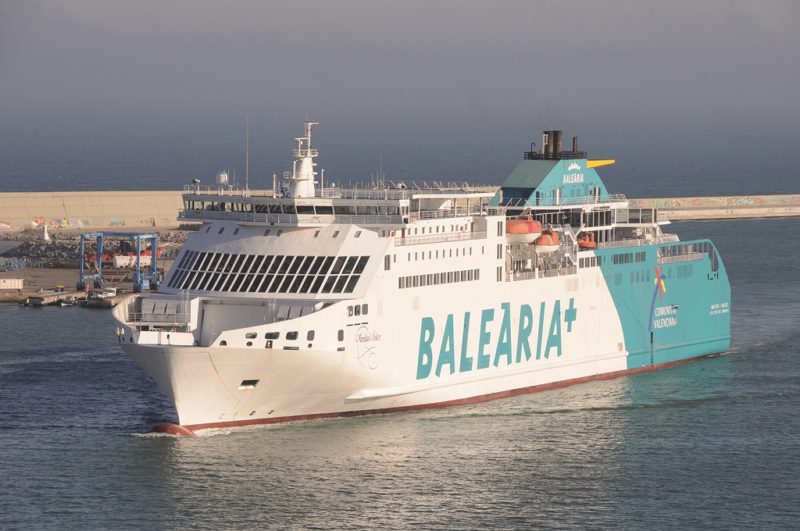

VEHICLE TERMINALS
Vehicles are imported and exported by the AUTOTERMINAL S.A. (82.0 hectares) and by the SETRAM S.A. (10.0 hectares), with vehicle parks with capacity up to 24,000 units, using five rail links, five ro-ro ramps, and 1,200 metres of berth length. Pure Car Carriers (PCC) and Pure and Truck Carriers (PCTC) vessels of Hoegh Autoliners, Wilhelmsen of Norway, Wallenius of Sweden, Eukor Car Carriers of South Korea, ARC Car Carriers of the U.S.A. and Ray Carriers are chartered by the car manufacturers or operate on their own bespoke Round the World routes. Car washing, paint and body repair, assembly of accessories, vehicle protection during transit, and customisation facilities are provided at both auto terminals.
PERISHABLE and BREAK-BULK CARGOES
Fruit is imported into Cold Stores in the port from Australia, New Zealand, Sumatra, Ethiopia, Chile, Argentina, Brazil, South Africa, Costa Rica, Colombia, China and the U.S.A.
The Port of Barcelona has the contract for the major tonnage of coffee imported each year into Spain by five major Spanish coffee warehousing companies from countries all over the world, each coffee with a distinctive difference in taste. Catalonia has ten wine regions, the largest of which, and the birthplace of Cava wine, is in the region of the market town of Villafranca del Penedes with a wine museum and a grand 14th century basilica. Wine is thus exported by wine tankers from the port, together with large amounts of San Miguel beer, and many other wines and spirits.
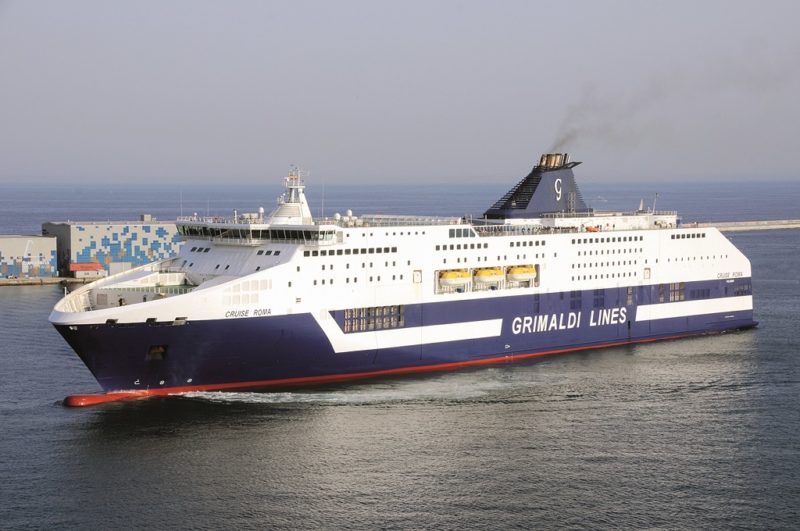
PORT STATISTICS
2017 2018 2019 2020 2021
Cargo (Million Tonnes)
61.499 67.756 65.885 59.507 58.352
Containers (Million TEU)
2.972 3.423 3.324 2.959 2.999
Passengers (Millions)
4.139 4.494 4.629 0.858 0.733
Vehicles (Millions)
0.838 0.810 0.778 0.480 0.466
Vessels
8,976 9,028 8,401 6,724 6,589
The very severe decreases in visiting passengers and their vehicles, and the total of visiting vessels during the two year Covid-19 emergency of 2020/21 is very clearly shown in the above table.
TUG FLEET
Rebarsa Remolcadores Group was founded in 1886 in Barcelona and has provided all towage and ancillary services such as oil pollution recovery, and waste removal ever since. Six powerful tugs are operated in Montbrio of 380gt built in 2007, Montclar of 380gt built in 2009, Montalt of 386gt built in 2009, Cala Gullo of 387gt built in 2016, Cala Sequer of 387gt built in 2017, and Cala Verd of 481gt and built in 2020 with a bollard pull of 95 tonnes. A powered waste collection barge is also operated.
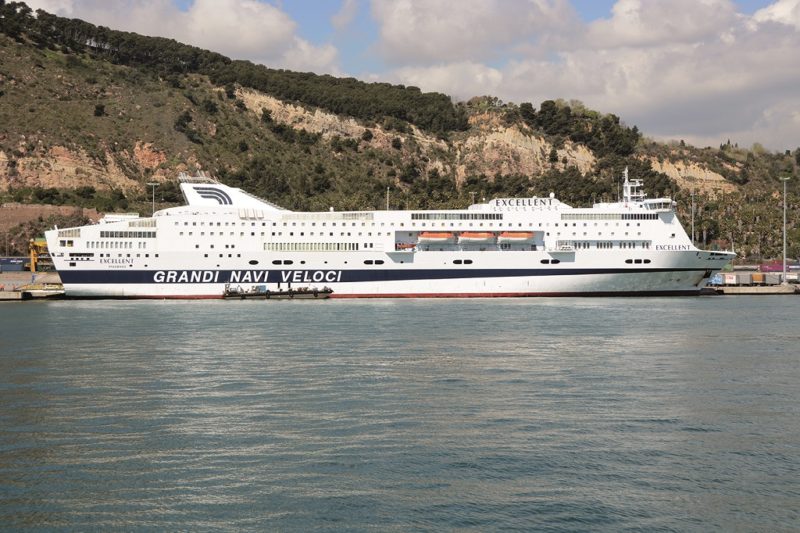
FERRY TERMINALS
- F1 DRASSANES FERRY TERMINAL between the World Trade Centre and the Placa de Drassanes.
- F2 BARCELONA FERRY TERMINAL on the Moll Sant Bertram.
- F3 GRIMALDI FERRY TERMINAL just south of the Porta d’Europa bridge on the shore side of the harbour.
- F4 PORT-NOU FERRY TERMINAL on the south end of Adossat Wharf.
The destinations, ferry terminal used, voyage times, and operator for the many ferry routes are as follows:-
Port Terminal Time (Hours ) Operator
Alcudia Drassanes 6 Balearia
Palma Port-Nou 8 Balearia
Palma Barcelona 8 Tras.
Ibiza Port-Nou 9 Balearia
Ibiza Barcelona 9 Tras.
Mahon Barcelona 9 Tras.
Ciutadella Drassanes 9 Balearic
Porto Torres Grimaldi 12.3 Grimaldi
Savona Barcelona 17 Grimaldi
Civitavecchia Barcelona 20 Grimaldi
Genoa, Barcelona 20.5 GNV
Tanger-Med Barcelona 26 GNV
Tangier Barcelona 28 GNV
Nador Barcelona 28.8 GNV
Ro-ro freight and multi-purpose cargo on trailers as well as in trucks of all kinds are also carried on the Ro-pax ferries on the above routes from all four ferry terminals.
BARCELONA FERRY COMPANIES
TRASMEDITERRANEA
‘La Tras’ is the colloquial name that Spanish people use for their much-loved national ferry line. New Year’s Day of 2017 was the centenary anniversary of the first day that their Spanish national ferry line began to run services to its many destinations including the Balearics, Ceuta and Melilla in North Africa, the Canaries, and the Spanish colonies of Fernando Po and Spanish Guinea in West Africa. Nine small companies came together on that day one hundred years ago, namely Maritima Barcelona, Gijonesa, La Islena Maritima, Menorquina, Navegaceon y Industria, Tintore (founded by Pablo M. Tintore in Barcelona in 1852), Valenciana and Vinuesa fleets. The actual instrument and deed of the constitution of Compania Trasmediterranea was signed in Barcelona before the Public Notary Antonio Sasot Mejias on 25th November 1916 by Joaquin Maria Tintore of Linea de Vapores Tintore, Enrique Garcia Corrons of Navegaceon y Industria S.A., Jose Juan Domine of Compania Valenciana de Vapores Correos de Africa, and Vicente Ferrer Pesset on behalf of Ferrer Pesset Hermanos companies.
Trasmediterranea lost its monopoly in 1998 on the lines that linked Spain with her islands and the two enclaves in North Africa due to liberalisation of the sector. The fleet was privatised in July 2002 for E259 million by a consortium consisting of leading Spanish transportation, logistics and construction group Acciona Logistica (60%), Caja de Ahorros del Mediterraneo, Compania de Remolcadores Ibaizabal, Agrupacion Hotelera Doliga, Suministros Ibiza and Naviera Armas. Later that year, the company changed its name to Acciona Trasmediterranea operating from a headquarters in Madrid, and although it had lost its monopoly it was still the leading ferry company that linked the Spanish mainland with her islands and her two enclaves in Northern Africa. The privatised company had a fleet of 26 ferries, and the frequency of these passenger services on conventional ferries was daily from Barcelona to Palma, six per week Barcelona to Ibiza, three per week Barcelona to Mahon, six per week Valencia to Palma, once a week Valencia to Ibiza and Valencia to Mahon, once a week Cadiz to the Canaries, and frequent daily services from Algeciras to Tangiers and jointly operated with Euroferrys, Comarit and Limadet Ferries. Fast ferries operated at forty knots at a frequency of six per day from Algeciras to Ceuta, and six per week from Barcelona to Palma, and frequently during the day linking Tenerife and Gran Canaria.
The centenary celebrations started in November 2016 and have continued right through 2017, with all twenty ferries painted with stylised red ‘100 and 1917-2017’ above the word ‘Trasmediterranea’ in the middle of both sides of their white hulls. The company sent out a Christmas card with a colour painting of a ferry of the 1950s to all employees, with best wishes for peace, happiness and friendship during 2017, the year of the centenary. A special webpage was created at www.trasmeships.es for all Trasmediterranea aficionados to enjoy. A long video was created of all the many company ferries that have docked at the beautiful port of Mahon on Menorca during the last one hundred years. An exposition of company photographs was held in the Museo de Castillo de San Carlos in Palma (Mallorca) from 20th January 2017 to 12th February 2017. The Madrid Naval Museum has an exhibition of 100 Years of Trasmediterranea. Messages of congratulation were sent by Managing Director Mario Quero Gil, and received at the Madrid headquarters of the company from many Spanish dignatories. It has been a very eventful first hundred years.
BALEARIA/BUQUEBUS
The newcomer fast ferry companies of Balearia of Spain and Buquebus of Uruguay also operate on the routes from Algeciras to Ceuta and Tanger Med. Eurolines Maritimes started operations under the Balearia brand in July 1998 with a group of former executives, captains and officers of the ferry company Flebasa. Balearia, as their name suggests, have their main routes to the Balearic Islands from mainland Spain, with their first fast ferry being Patricia Olivia with seats for 600 passengers and room on the vehicle deck for ninety cars and five lorries. Patricia Olivia was transferred in 2011 to Balearia Caribbean Ltd. and renamed Pinar del Rio for the ‘Bahamas Express’ service between Fort Lauderdale and Freeport.
In April 2003, Balearia began operating services on the Strait of Gibraltar from Algeciras. Current fast craft on the route include the near sisters Jaume I and Jaume II, built at Hobart by Incat Tasmania (Pty.) Ltd. and purchased between 2005 and 2007. They have seats for 600 to 700 passengers and space for around 150 cars, with maximum service speeds of 43 knots from four powerful Ruston Paxman or Caterpillar diesels driving four water jets. The fast craft Avemar Dos also operates from Algeciras, as well as three conventional ferries to Ceuta and Tanger Med from Algeciras in Poeta Lopez Anglada built in 1984 as Champs Elysees for SNCF, Passio per Formentera built in 2009 for the Balearics routes and powered by Rolls Royce Marine diesels.
The two fast ferry companies, Balearia and Buquebus, operated in partnership, until in September 2007 Buquebus was taken over by Balearia and became a subsidiary. Ceuta is reached in under half an hour on ten daily sailings, and Tanger Med in under one hour from Algeciras on four daily sailings. They have a small open air vantage point high up on their aft decks, which is very good for ship photography, as well as giving a better impression of their very fast forty knot speeds.
GRIMALDI
The Grimaldi Group was founded in 1947 by the brothers Guido, Luigi, Mario, Aldo and Ugo in Naples operating general cargo ships worldwide. A large fleet of freight ro-ros with prefixes of ‘Grande’ or ‘Repubblica’ to their names now operate on worldwide routes including to South America. A large fleet of thirteen cruise ferries is currently operated on the routes Barcelona to Civitavecchia (6 times weekly), Barcelona to Livorno (5 times weekly), Barcelona to Savona (5 times weekly) and Barcelona to Port Torres in Sardinia (4 times weekly). A large fleet of thirteen cruise ferries is currently operated, seven of which have ‘Cruise’ prefixes to their names e.g. Cruise Barcelona and Cruise Roma of 54,310gt and built in 2008 with a service speed of 24 knots for the route to Civitavecchia. They run to a tight schedule of six hours turnround at the Port of Barcelona, with manoeuvring of their big hulls of an overall length of 253.8 metres, moulded beam of 30.41 metres, and a loaded draft of 6.9 metres, expertly accomplished. A dozen new ‘Eco’ economic freight ro-ros have been ordered from the Jinling yard in China, with the first quartet completed as Eco Barcelona, Eco Valencia, Eco Livorno and Eco Savona.
GRANDI NAVI VELOCI (GNV)
GNV was created in 1992 by Aldo Grimaldi initially as a subsidiary of the Grimaldi Group. The first large Ro-pax ferry, Majestic, began service on the Genoa to Palermo route, followed by her sister Splendid a year later on the Genoa to Port Torres route. The similar sized Ro-paxes Excelsior, Excellent and Fantastic had begun their careers in the Western Mediterranean within a few years on Barcelona to Genoa, Livorno to Palermo and Genoa to Olbia routes. In 2002, the new large sister cruise ferries La Superba and La Suprema of 49,270gt entered service on the Barcelona to Genoa route. A new Genoa to Barcelona and on to Tanger-Med and Tangier route was established in 2008, with Excelsior, Excellent and Fantastic, all of 29,550gt and accommodation for 2,400 passengers, currently used on one of the longest ferry routes in the Mediterranean. Two years later, the company was acquired by the MSC Group after the Grimaldi family and the Grimaldi Group had ceased ownership. A big fleet of thirteen cruise ferries is currently owned.
TRASMED
Trasmed Ferries was founded in July 2021 and is based in Valencia and owned by the Grimaldi Group. The big cruise ferries Cruise Barcelona and Cruise Roma operate for Grimaldi from Barcelona to Civitavecchia, while those passengers travelling from Barcelona to the four Balearic Islands use the Trasmed ferries City of Barcelona, Ciudad de Mahon, Ciudad de Alcudia, Citudad de Granada and Ciudad de of Palma. The routes from Barcelona to other ports in Italy are also covered by Grimaldi ferries. Menorca Lines are operated by Trasmapi and use the sisters Chenega and Fairweather from Barcelona to Mahon.
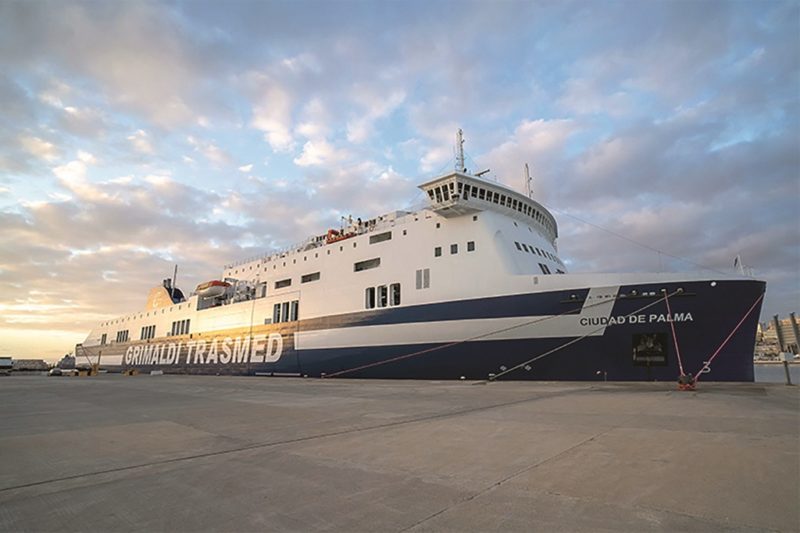
SUMMARY
The Port of Barcelona is well placed today as an existing very large hub in the Western Mediterranean, and is keen to move ahead with new developments to increase the import and export cargo tonnage handled in the port. This forward looking vision of the Directors of the Board that has made the port into a leading logistics hub in the Mediterranean has included:-
- The decision to move to the European rail gauge.
- Expansion granted for the Hutchison Container Terminal.
- The new combined cycle power plant
- Expansion of ZAL (Logistics Activities Zone).
- Expansion of the Zona Franca and Free Trade Zone.
- The announcement in June 2021 that the directors had given approval for a new Cruise Terminal to be built for exclusive use by MSC Cruises on a 31 year lease.
- Royal Caribbean International (RCI) have been given approval to base their cruise ship Harmony of the Seas of 227,700gt with accommodation for 5,488 passengers as a home-ported cruise ship for turnrounds in the Port of Barcelona on seven night Western Mediterranean cruises.


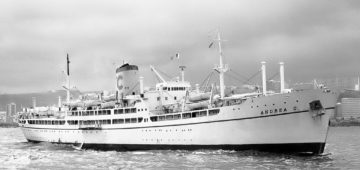



Comments
Sorry, comments are closed for this item